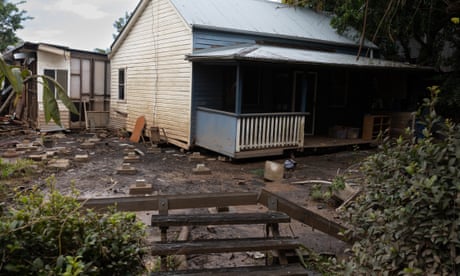- by foxnews
- 08 Apr 2025
Flood-affected Lismore residents with nowhere to go return to homes deemed uninhabitable
Flood-affected Lismore residents with nowhere to go return to homes deemed uninhabitable
- by theguardian
- 20 Mar 2022
- in news

Residents in Lismore have been left with no choice but to move back into their houses that have been deemed uninhabitable, with some sleeping on swags in mouldy rooms without electricity, as they are unable to find safe accommodation three weeks after floods devastated the town.
The State Emergency Service had deemed more than 3,600 homes across the New South Wales northern rivers region as uninhabitable and on Friday some residents were living in homes that had been as assessed as such.
In one case, a homeowner had returned to their property which had been condemned for demolition after being assessed as structurally unsound, and had warning tape erected at its entrance, however they did not want to be interviewed.
Some homes in South Lismore were swept off their foundations, but they remained intact, despite needing renovations and structural repairs.
While they were able to rely on people who opened their homes to them, countless other residents also required temporary accommodation.
And so on Monday, after weeks of living in cramped conditions with other flood evacuees, the Lee family made the difficult decision to return to their home, despite its status as uninhabitable.
While water was running, the Lees were unsure if it was safe, so were drinking bottled water. The house relied on a portable generator for electricity, and its mountain of flood-ruined possessions in the front yard was yet to be collected.
Outside, the smell of dried dirt and sewage lingered. Inside, water damage and mould was evident. It was hot inside the rooms, and flood damage left it largely unprotected from the elements.
The family had been told it would take more than six months for their home to be rebuilt and safe for them to move back in.
Despite this, Andy said one benefit of the fact they had returned to the home was that they could protect against looters looking to steal donated goods, such as fridges and washing machines, that had already arrived at some homes.
The family were desperate for more secure medium-term accommodation and frustrated at the current options available to them. They had attempted to apply for one of the 40 mobile homes the state government delivered to Lismore for flood-affected victims, but had not heard back from the government.
Regardless, the mobile units were not large enough to accommodate all four of them for multiple months.
Along their street and those intersecting, the story was similar. Piles of possessions remained uncollected at most homes, and stories of families forced to return were common.
Looking over the pile of ruined possessions in his front yard, Andy noted that the house was not tied down to the bricks that elevate it, and only sat on them, and was concerned about its future safety. However, he counted the family as fortunate, as they had an insurance policy in place.
- by foxnews
- descember 09, 2016
Ancient settlement reveals remains of 1,800-year-old dog, baffling experts: 'Preserved quite well'
Archaeologists have recently unearthed the remarkably well-preserved remains of a dog from ancient Rome, shedding light on the widespread practice of ritual sacrifice in antiquity.
read more


